

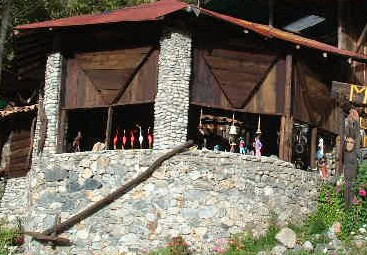 I
was amazed at the difference between Arassari Trek and Gravity Tours. Alan
picked us up early in the morning, and we left immediately. He is originally
from Barbados, so he speaks excellent English. (The man from Gravity spoke
English too, but not as well.) He also had a driver other than himself, allowing
him to point things out and tell us about things without needing any attention
on the road. For that matter, the fact that he had gone through the effort of
setting up an alternate plan for us last night said a lot too.
I
was amazed at the difference between Arassari Trek and Gravity Tours. Alan
picked us up early in the morning, and we left immediately. He is originally
from Barbados, so he speaks excellent English. (The man from Gravity spoke
English too, but not as well.) He also had a driver other than himself, allowing
him to point things out and tell us about things without needing any attention
on the road. For that matter, the fact that he had gone through the effort of
setting up an alternate plan for us last night said a lot too.
The first place we stopped was for breakfast. We were in the Andes, at a higher elevation than Mérida, and the morning was chilly. The place (I am not sure it qualifies as a restaurant) we were at had sculptures done in every material from junk metal to baked clay. Alan pointed out a few of famous people in Venezuelan history, such as Bolivar, while we waited for breakfast to be served. I looked at miniatures of airplanes, cars, and other things done with an ingenious collection of materials. Breakfast was a huge affair, with coffee, pancakes, arepas, and fruit. The air was so cold, however, that while there was no risk of our milk getting warm, we always took the second pancake and left the top one for insulation. All in all, however, it was a good meal.
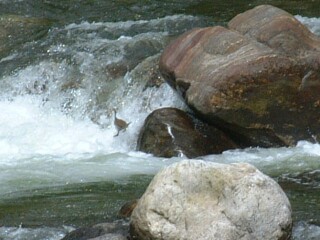 After
breakfast, we returned to the van and traveled some more through the Andes. We
stopped at one bridge to watch some rare torrent ducks (my mom loves bird
watching, and Alan seemed to know every bird in the area.) We got a special
treat aside from the ducks; an osprey had hurt itself, and was drifting down the
stream. It was great to be able to see one that was so close and moving so
slowly we could watch it through the binoculars.
After
breakfast, we returned to the van and traveled some more through the Andes. We
stopped at one bridge to watch some rare torrent ducks (my mom loves bird
watching, and Alan seemed to know every bird in the area.) We got a special
treat aside from the ducks; an osprey had hurt itself, and was drifting down the
stream. It was great to be able to see one that was so close and moving so
slowly we could watch it through the binoculars.
We still had a long drive ahead if us after we left the bridge, getting to the rafting center. It rained a lot up in the mountains, but stopped as we descended to the camp. Alan explained along the way that the nearby section off the river was class two to three rapids, which are easy. When he learned that we had all rafted before, he mentioned that there was a more difficult stretch further up, which he might go down with those of us who wanted to. Alan also said that we could go down the easier section with inner tubes, supposedly a much more exciting and challenging method. I thought that the tubing sounded excellent. I had never ridden an inner tube in white water, but the way Alan described sounded terrific.
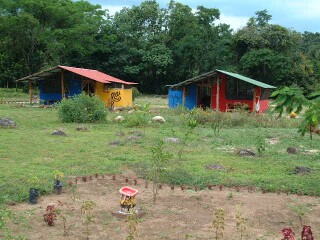 By
the time we reached the rafting camp, we were out of the mountains and into a
middle level of comfortable temperatures and thick forests. Alan explained that
this was actually part of Los Llanos, but on higher ground above most of the
area where we would spend the next few days. It was not raining as we entered
the camp, though heavy clouds hung over the mountains we had just descended
from. It was also time for lunch, and food was already waiting for us.
By
the time we reached the rafting camp, we were out of the mountains and into a
middle level of comfortable temperatures and thick forests. Alan explained that
this was actually part of Los Llanos, but on higher ground above most of the
area where we would spend the next few days. It was not raining as we entered
the camp, though heavy clouds hung over the mountains we had just descended
from. It was also time for lunch, and food was already waiting for us.
Lunch was set out on one of several long tables that stood under a large roof on one side of the camp. This mostly open structure also contained the kitchen, restrooms, and couches where people could sit and talk in comfort. Behind the kitchen was the small house where the people who ran the camp lived. On the other side of the eating area from the house was a field that went right up to the edge of the forest. The middle of the camp contained several small gardens and a few trails leading around them. The cabins where we would sleep were opposite the eating area, on the other side of the camp. Across the camp from the entrance was a large structure that looked like a huge metal barn or a small hanger, with immense doors and sheet metal walls. This was where all of the gear, including the huge rafts, stacks of inner tubes, and a collection of bikes on a rack, was kept when not in use.
We had an excellent lunch and moved our gear into the cabins. The adults took one of the cabins, and we kids took the other. Inside our cabin were enough bunk beds for ten or so people easily, a small bathroom, and almost nothing else. The top two feel of wall was window most of the way around the cabin, allowing a comfortable breeze to blow through the room. The windows were completely open except for mosquito netting, but the eaves came out far enough that there was no risk of rain blowing in through the windows. From the windows, we could almost see the river, which rolled by a few yards beyond the cabins, below a tree covered bluff.
After we had settled in, I returned to the sitting area. When we had first arrived, I had noticed a backgammon board. Since it would be a while before we went out on the river, I hoped to pass the time with a game or two. Nobody from our group wanted to play, but a Venezuelan girl who was staying at the camp offered me a game. Her name was Beatrix, and if she spoke any English at all, I never heard her use it. However, she wanted to play, and backgammon needs little talking. She beat me in both of the first two games we played, but during that time, my mom (who is quite fluent in Spanish) chatted with her, translating for me. Beatrix was twelve years old, and had family both at the camp and at the place we had stopped for breakfast. Aside from backgammon, she also knew some other games, and got along quite well with Amanda and Kat as well.
When Alan told us that it was time to get on the river, I changed into swimsuit and went into the large metal structure. Inside, we selected life preservers, helmets, and took paddles. We took a large inflatable raft, piled our paddles into it, and carried it down to the river. Alan gave us some instructions as we placed the raft in a small area on the side of the river where there was no current to sweep it away. We swam for a few minutes, then all of us, including Alan and a Spanish-speaking river guide, got into the raft and pushed off.
As soon as we paddled onto the river, the gray clouds overhead delivered the rain they had been threatening for hours. However, none of us really minded. In fact, I rather enjoyed it. As I put it, rain is only something to avoid if you want to stay dry, and anybody who doesn’t want to get wet has no place on white water. I thought that both the swimming and paddling were more fun in the rain than without it.
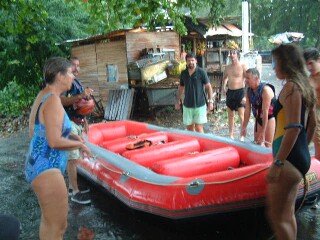 After
we went over the first few rapids, the rain increased, and began to hear thunder
and see flashes of lightning. Although we were in no real danger from the storm
directly, Alan warned us that since it had rained for so long in the mountains
that this river came down from, there was a real danger of a flash flood. He
told us that we should be able to finish this raft trip, but that if we saw the
water turn muddy brown, we needed to get off the river as quickly as possible.
Other than that, we went on much as before. The storm raged overhead, adding a
feel of adventure, and the rain pounded down harder than ever.
After
we went over the first few rapids, the rain increased, and began to hear thunder
and see flashes of lightning. Although we were in no real danger from the storm
directly, Alan warned us that since it had rained for so long in the mountains
that this river came down from, there was a real danger of a flash flood. He
told us that we should be able to finish this raft trip, but that if we saw the
water turn muddy brown, we needed to get off the river as quickly as possible.
Other than that, we went on much as before. The storm raged overhead, adding a
feel of adventure, and the rain pounded down harder than ever.
Our first real excitement was when we got ourselves stuck in a large hydraulic hole. A hydraulic hole is a place where a large rock or other obstacle forms a barrier in the river that most of the water goes around, but some goes over the top. Behind the rock, an eddy forms that is normally essentially free of any current. However, the water flowing over the rock flows down into the eddy, and swirls back to the surface going in the opposite direction of the river. For a swimmer, this is a real risk; a hydraulic hole can pull somebody underwater and make it difficult to surface, or the reverse current can slam a swimmer against the rock.
Although the hydraulic hole we positioned the raft over would have been very dangerous to anybody swimming, it could not pull down the large and very buoyant raft. Our intention was to get ourselves into the hole (which took a few tries) then get out again. However, once we positioned the boat in a stable position over the hole, we discovered we could not get out. The hydraulic hole’s suction could not pull the raft underwater, but it could hold it against our best efforts with the paddles. As the bottom of the raft slowly filled with water and we wondered how we were going to get out of this, lightning flashed directly overhead, striking to the ground. Immediately we heard a sharp crack like a gunshot as a tree was blasted, somewhere within a few hundred feet of us. Simultaneously, thunder roared overhead, so loud and close I wanted to cover my ears. As the echo of the thunderclap passed, our guides got up, went into the river, and physically pushed the raft out of the hole, then jumped back into their paddling positions before we drifted away.
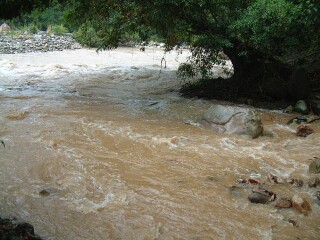 The storm continued as we
made our way down to the exit point. Lightning, thunder, and rain never went
away, but there was only one other point where lightning struck nearby. It
happened while we were on the side of the river. There were some branches
hanging over us, so our guide had asked us to put our heads down. A moment
later, before we were out from under the branches, lightning flashed overhead
again. I didn’t see much of the strike this time, but I heard it blast a tree
on our side of the river, sounding even closer than the first strike. As before,
there was a gunshot-like snap simultaneously with bone shaking thunder.
The storm continued as we
made our way down to the exit point. Lightning, thunder, and rain never went
away, but there was only one other point where lightning struck nearby. It
happened while we were on the side of the river. There were some branches
hanging over us, so our guide had asked us to put our heads down. A moment
later, before we were out from under the branches, lightning flashed overhead
again. I didn’t see much of the strike this time, but I heard it blast a tree
on our side of the river, sounding even closer than the first strike. As before,
there was a gunshot-like snap simultaneously with bone shaking thunder.
We reached the exit point safely; riding one last big rapid before we moved to the bank near a car bridge that spanned the river. The riverbanks were covered with small, muddy streams feeding into the river, and the water was slowly turning the color of mud. We got out before the water level rose noticeably, however. The van was at the top of the hill. We loaded the raft onto the top rack before climbing in, with rain pouring down all the time. We were all soaking wet, and it was very nice to get back to the rafting camp, with towels, dry clothes, shoes, and umbrellas, not to mention roofs.
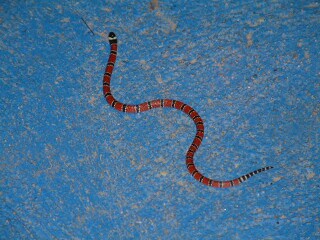 Once we were all changed
and had our umbrellas, Alan called us out to the bluff overlooking the river.
The river was now completely brown, as well as flowing a little faster. The real
surprise was that rocks that used to break the water’s surface were now
invisible. The level had risen two or three feet, and in the space of a few
minutes. The flash flood had arrived. Over the next hour, the water continued to
rise, until even the island a little above our entry point had disappeared, and
the path we had taken to the river was flooded, even a few steps up the stairs
that led into the camp.
Once we were all changed
and had our umbrellas, Alan called us out to the bluff overlooking the river.
The river was now completely brown, as well as flowing a little faster. The real
surprise was that rocks that used to break the water’s surface were now
invisible. The level had risen two or three feet, and in the space of a few
minutes. The flash flood had arrived. Over the next hour, the water continued to
rise, until even the island a little above our entry point had disappeared, and
the path we had taken to the river was flooded, even a few steps up the stairs
that led into the camp.
The rain at the camp finally stopped, but it was a long time before the river started to go down, and Alan said it would probably be a few days until the water returned to its normal level. Beatrix and I played some more backgammon while we waited for dinner, and then the girls went out to the swings that hung from a tree on the edge of the forest. After an excellent dinner, we passed the time playing games and telling stories. Before we went to bed, however, a tiny baby coral snake was found near the house of the people who worked at the camp. Alan wasn’t sure if it was large enough to be poisonous, but said that the young ones could be more dangerous, since unlike adult snakes they were prone to release all of their venom in the first bite, leaving no reserve. Adult coral snakes can be very dangerous, but this one was only five or six inches long. Even so, nobody went very close to it, though we took some pictures. After the excitement over the snake subsided, we returned to our cabins and went to bed.
Top Level: Home | Destinations | Cruising Info | Underwater | Boat Guests | Ocelot | Sue | Jon | Amanda | Chris | Site Map | Make a Comment
|
If our information is useful, you can help by making a donation |
Copyright © 2000‑ Contact: Jon and Sue Hacking -- HackingFamily.com, svOcelot.com. All rights reserved.